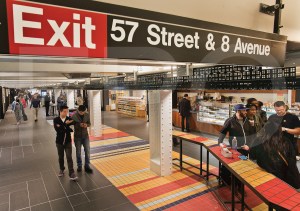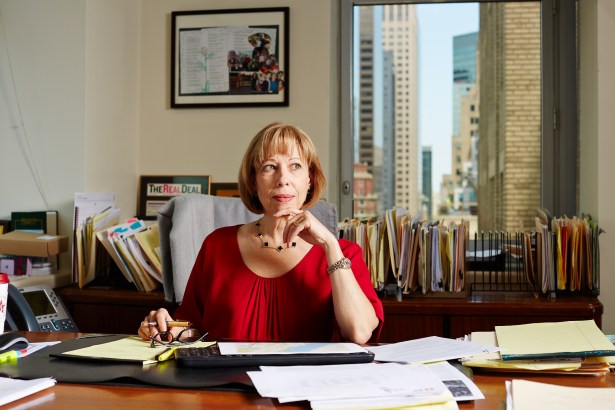Rockin’ Robin: Lansco’s Robin Abrams Is Dancing to Her Own Retail Beat
By Terence Cullen May 18, 2016 11:00 am
reprints
Robin Abrams has had a busy couple of weeks.
The vice chair at the Lansco Corporation and her retail team just finished leasing up TurnStyle, the shopping hub underground at the Columbus Circle subway station. Developed by Susan Fine of OasesRE and Columbus Development LLC, the retail center opened at the end of last month and is in a 27,000-square-foot-long corridor that Ms. Abrams and her team filled with brands such as Starbucks, Lush and Dylan’s Candy Bar.
No doubt, there were late nights and early mornings putting the deal together. It’s a good thing Nespresso is also one of her clients.
But TurnStyle is hardly all that’s keeping her going. Ms. Abrams is currently consulting Quadriad on the retail component of a multiblock development around Steinway Street and 35th Avenue in Astoria, Queens. When she sat down with Commercial Observer last week at Lansco’s 415 Madison Avenue offices, she had just come back from Chicago and Rochester, N.Y., to meet with potential tenants (it was too soon for her to tell us who those occupants might be).
The Yorkville resident grew up in the Chicago area and joined Lansco more than 35 years ago while she was moonlighting as a professional ballet and modern dancer. Now a married mother of two (she has a 26-year-old son and a 23-year-old daughter who just got her master’s degree from Johns Hopkins University), Ms. Abrams went full time into the brokerage business in the 1980s and hasn’t looked back.
Can you run us through what you did to make TurnStyle happen?
TurnStyle is a great example of a long-term project. We worked with the developer, Susan Fine, and together put in a lot of time and effort in determining what the project should consist of, how we were going to demise the spaces, who we were going to reach out to and what our story was going to be. That was really important because we could have tenanted this 10 times over with the Subways and the Dunkin’ Donuts of the world, probably at similar rents to what we achieved. It wasn’t about one particular space. It was about big picture and looking at the whole and understanding that it was a transformation that was going to take a couple of years but that ultimately it would be pretty dynamic and successful.
We knew that we wanted a food component. We knew that we wanted a dry-use component and that we needed some national tenants in order to get some credibility and satisfy whomever would want to finance the project, which is why we reached out and secured Lush, Papyrus, Starbucks and Dylan’s Candy Bar in addition to looking at lots of local and artisanal uses as well. Both dry and food so that it would be a really nice energy and have its own unique identity and not just be like walking through a shopping mall.
So sort of like a Chelsea Market that has tenants such as a Posman Books and a Num Pang?
Exactly. And Chelsea Market was a great tool and had some impact. We looked at all of the mostly food-related projects all over the city because we were very fortunate that some have been established and very successful. We were out at Smorgasburg, we were at Gotham Market and we were at Chelsea Market. We were at Grand Central and all the transportation hubs looking at what was good and what was bad. We certainly let all of that impact who we approached and ultimately did deals with.
Was Lansco mostly focused just on finding the tenants? Or were you also involved in securing the agreement with the Metropolitan Transportation Authority?
We initially were brought on to consult and lease. We did not get involved in the negotiations with the MTA. Susan Fine and her attorneys dealt with that. She came from the MTA [as the director of real estate in the 1990s] and she had obviously a relationship and past experience.

What we did get involved in was working with her from the very early stage to conceptualize what the project should consist of and then to effectively tell the story so that we could engage prospective retailers. If we took them to the site and walked them through, it was a turn off. It was really hard for a lot of people to understand what it was going to be without us really spoon feeding our vision to them.
There were a lot of conversations that didn’t specifically relate to, “We’re going to call tenant X, Y, Z and see if they’re interested.” We needed to work with Susan to develop a product that would attract retailers where they could be comfortable and a dynamite environment could be created for the project to be a success.
We sat in on meetings with Susan from the get-go, talking about what to name the project. Originally there were other ideas. When we came upon “TurnStyle” everybody loved it because we thought that it evoked a sense of style and fashion as well as relating to the turnstiles that people go through at the subway. There were many meetings talking about what do we name the project, how do we demise these spaces, what sizes will tenants be looking for, what utilities do we need to bring? [We were] working with the engineers about what kind of floor covering will mask the vibration and sound yet stand up to all of the traffic.
How does this compare to any other development consulting that you’ve done?
It’s probably been the most rewarding project we’ve worked on because it’s unlike anything else that we did. There were a lot of naysayers who just didn’t get transit retail and weren’t convinced that area could be improved the way it was and that exciting environment could be created. We spent two to three years with Susan working on it. The lease process itself wasn’t easy; it was a pretty lengthy lease that was subject to the MTA master lease, so it was a process getting through the lease with each of the 30 tenants that would go into the project.
How many people from Lansco worked on it?
There were three people that spent a good portion of their day, every day, on the project. [It was myself,] Lisa Rosenthal and Ryan Bergman. All three of us have extremely different styles with regard to how we operate and different personalities. There was a very specific game plan put in place whereby each of us was the point person with regard to different tenants.
What’s a must-see if one is to go there?
Every tenant is unique. We were not going to [put Starbucks in], but we eventually put them in the project, front and center. They’ve opened a different model. It’s a small footprint. It has a counter where you walk in, you place your order, then you go to [another] counter and pay and pick it up. But while you’re doing that it’s already being processed. They’ve cut the delivery time from the time you order until you actually get your beverage. That’s really unique. For me it was exciting to see that they did something different in the project.
I particularly like what Lush did in their space, and I think they’re killing it. They’re extremely busy. There are hundreds of thousand of people walking through the project every day. I think what they’ve done is really bright and colorful and well merchandised.
Do you see this as something that might be replicated to other big transit hubs?
Yes, I do see it happening. I think that first off the MTA is going to look to other areas where they have potential for retail in the subway stations and try to incorporate more of these kinds of projects. We already see that there are some things coming online with requests for proposals for available retail space in a couple of subway stations.
We’ve gotten calls from a couple of other entities that are looking to develop and/or invest in projects focused around transit centers in other cities, asking us our opinions about some of their potential to develop the retail. It’s interesting because it’s on everybody’s mind now.
Who are some other clients you’re working with right now?
We’re representing [bed linens-maker] The White Company and looking to do their first U.S. store. We’re working with Nespresso café to do the first of their new concept. We’re working with [photo art gallery] Lumas in multiple markets around the country.

Can you discuss the Nespresso concept?
I don’t even know if I’m supposed to be discussing this. Nespresso has now got their flagship locations, and if you go down to Soho they no longer serve coffee other than as giving samples of the different coffees that they sell. But they don’t have the sit-down café where you order and pay for food and beverage. There is a concept that will incorporate that separately.
Any plans for the International Council of Shopping Centers convention in Las Vegas?
We’re meeting with various developers and landlords to learn about some of their available locations that may be a good fit for some of our tenants. We’re meeting with several tenants that we work with already; we’re meeting with new tenants we don’t work with to talk about potential opportunities. We have a busy schedule.
How long have you been at Lansco?
I started at Lansco in 1979, so gosh, 36 years. It’ll be 37 years. Oh, my God, it’s been 37 years.
How did you get into retail brokerage?
I came to New York fresh out of college with a degree in dance and Spanish literature [from the University of Illinois at Urbana–Champaign]. I danced for about five years. Through a friend I had gone to university with I interviewed at Lansco the week I arrived to support two of the partners as an admin, four hours a day while I danced and auditioned. I ended up with the Modern Dance Company and a ballet company and worked here a few hours a day. When I quit dancing, I started to work full time supporting them. And a couple of years later I got my license, in 1987, and decided to focus on retail and build the department here. It was mainly an office leasing firm at the time. Alan Victor, one of the partners, had just done the Polo Ralph Lauren [flagship store at the] Rhinelander Mansion, and I thought that was really cool and exciting and creative and much less static than office leasing. So he and I took what he had begun with a couple of initial retail deals and built a department with about 20 to 25 retail brokers focused on tenant rep and project-oriented landlord agency work.
We’re not akin to an RKF or a Winick Realty Group. I think those are great companies, and they do a wonderful job of what they do. But we’re not landlord agents in the sense that we don’t put our signs all over the city. So I just kind of fell into it. It’s interesting because I think years ago that that’s what happened with many people, and in particular that’s what happened with people who ended up in real estate. I don’t think young people went to school to be brokers. I don’t think they came out of school thinking they’d be brokers.


